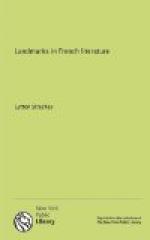The solidity of Flaubert’s work, however, was not unaccompanied with drawbacks. His writing lacks fire; there is often a sense of effort in it; and, as one reads his careful, faultless, sculpturesque sentences, it is difficult not to long, at times, for some of the irregular vitality of Balzac. Singularly enough, Flaubert’s correspondence—one of the most interesting collections of letters in the language—shows that, so far as his personal character was concerned, irregular vitality was precisely one of his dominating qualities. But in his fiction he suppressed this side of himself in the interests, as he believed, of art. It was his theory that a complete detachment was a necessary condition for all great writing; and he did his best to put this theory into practice. But there was one respect in which he did not succeed in his endeavour. His hatred and scorn of the mass of humanity, his conception of them as a stupid, ignorant, and vulgar herd, appears throughout his work, and in his unfinished Bouvard et Pecuchet reaches almost to the proportion of a monomania. The book is an infinitely elaborate and an infinitely bitter attack on the ordinary man. There is something tragic in the spectacle of this lonely, noble, and potent genius wearing out his life at last over such a task—in a mingled agony of unconscious frenzied self-expression and deliberate misguided self-immolation.
In poetry, the reaction against Romanticism had begun with the Emaux et Camees of THEOPHILE GAUTIER—himself in his youth one of the leaders of the Romantic School; and it was carried further in the work of a group of writers known as the Parnassiens—the most important of whom were LECONTE DE LISLE, SULLY PRUDHOMME, and HEREDIA. Their poetry bears the same relation to that of Musset as the history of Renan bears to that of Michelet, and the prose of Flaubert to that of Hugo. It is restrained, impersonal, and polished to the highest degree. The bulk of it is not great; but not a line of it is weak or faulty; and it possesses a firm and plastic beauty, well expressed by the title of Gautier’s volume, and the principles of which are at once explained and exemplified in his famous poem beginning—
Oui, l’oeuvre sort plus
belle
D’une forme au travail
Rebelle,
—Vers, marbre,
onyx, email.
The Parnassiens particularly devoted themselves to classical subjects, and to descriptions of tropical scenes. Their rich, sonorous, splendidly-moulded language invests their visions with a noble fixity, an impressive force. Among the gorgeous descriptive pieces of Leconte de Lisle, the exquisite lyrics of Sully Prudhomme, and the chiselled sonnets of Heredia some of the finest and weightiest verse of the century is to be found.




